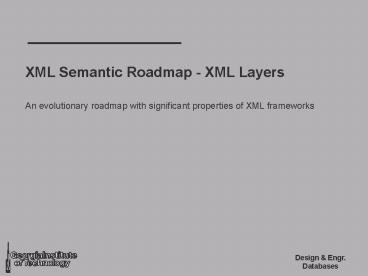XML Semantic Roadmap XML Layers PowerPoint PPT Presentation
1 / 19
Title: XML Semantic Roadmap XML Layers
1
XML Semantic Roadmap - XML Layers
An evolutionary roadmap with significant
properties of XML frameworks
2
Pure XML Schema and data together Explicit
metadata No logic in processing No data
types (Issue of matching syntax across
documents)
3
DTDs (Document Type Definitions) External
separate schema from data, user defined
types Some data types enumeration, IDs, pointers
(all strings) Cardinality zero, 1,
many Required and optional data No automatic
processing of DTDs
4
XML Schema Types integer, short, byte, long,
float, string, ID, Idref, Language, time, date,
month, year, enumerations User defined types
Type extensions (similar to inheritance) Type
restriction ordered, unordered or subset of
attributes Automatic interpretation of DTDs and
data Cardinality defined as constraints zero,
1, many Entity-attribute - like Multiple name
spaces (within a schema)
5
http//www.w3.org/2001/XMLSchemaint
XML Schema Types
6
- QUERY Languages for XML
- XML-QL
- Xquery
- path expressions
- element constructors
- FLWOR ("flower") expressions For-Let-Where-Order-R
eturn - list expressions
- conditional expressions
- quantified expressions
- datatype expressions
for d in document("depts.xml")//deptno let e
document("emps.xml") // employeedeptno
d where count(e) gt 10 order by
avg(e/salary) descending return ltbig-deptgt
d, ltheadcountgtcount(e)lt/headcountgt,
ltavgsalgtavg(e/salary)lt/avgsalgt
lt/big-deptgt
7
RDF (Resource Description Framework) (data
model) Global distributed identifiers used as
references Binary relations Types Uses XML
Schema types Primitive Datatypes string,
boolean , decimal , float , double , duration ,
dateTime , time, date , gYearMonth , gYear ,
gMonthDay , gDay, gMonth , hexBinary,
base64Binary , anyURI , QName , NOTATION
Although descriptions can be nested, all
resource tags are global Container Elements as
aggregations Bag, Seq, Alt, List Reification
statements about statements
8
RDF Schema (RDFS) Supports Classes (as well as
Types) Class hierarchies and inheritance
(subsumption relation) Multiple inheritance
(subsumption) Properties are defined globally and
are also related by subsumption Data types are
only literals Constraints for domain and
range Formally defined in logic supports
limited inferences
9
RDF Schema structure
10
OWL Ontology Language Based on DAMLONT and OIL
and DAMLOIL Formal semantics Class subsumption,
Equivalence, Consistency (set theoretic), tests
for classification Infer relationships between
classes Check consistency of definitions and
knowledge Automatically classify instances into
classes Relies on reasoning engines FaCT and
RACER
11
OWL Ontology Language Uses a form of logic
called Description Logic Constraints (disjoint, )
on subclasses Set combinations of
classes Cardinality restrictions Explicit
specification of transitivity, of unique, and
inverse relations Variants of OWL
Full Superset of RDF and RDFS (not fully
decidable) OWL DL (Description Logic) (subset of
RDF and RDFS) (fully decidable) OWL Lite
12
OWL Ontology
13
Comparisons
14
Product Modeling Using Ontologies
The future direction of product modeling
15
Product Modeling Using Ontologies
16
Product Modeling Using Ontologies
17
Product Modeling Using Ontologies
18
Future product modeling will be based on
automatic mappings between "published" datasets
Automatic mappings will be between equivalent
data types and subsumed related ones
Will realize "plug-and-play" modeling exchange
19
Summary
All product modeling needs to start with process
modeling
ER and mapping between a conceptual language and
an implementaiton (SQL)
ISO-STEP technology and EXPRESS - the current
product modeling standard
XML and the Semantic Web - the future direction
of product modeling

